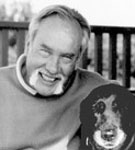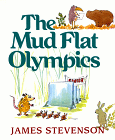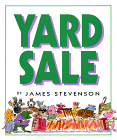Featured Author and Illustrator: James Stevenson

A search of the Internet reveals little. Even from his publisher, it's not easy to get any personal information on James Stevenson. We know that he has written and or illustrated more than 100 books for children and that he lives in Connecticut. We know that his cartoons and drawings often appear in The New Yorker. For the rest of the information about this talented and prolific man, we must turn to his work.
We can begin to estimate his age by such books as Don't You Know There's a War On (Greenwillow, 1992. ISBN: 0688113842.Order Info.) and Higher on the Door (Out of Print. Order Info.). Those books and his books of poems such as Popcorn (William Morrow & Company, 1998 ISBN: 0688152619. Order Info.) lead us to believe that he was a child of around 10 during World War II.
On the bookflap of When I Was Nine is a picture of James sitting on a fence near Cliff, New Mexico in 1939 with his mother, Winifred Stevenson, and his brother Eric. James looks to be about nine. The text of the book tells us he could see the Hudson River from the big beech tree in his backyard. The photograph was taken on a family car trip out west. The text also tells us that his father was a bugler in World War I and in Don't You Know There's a War On we learn that he went back into the service during World War II. We also know from that book that his mother read to him.

That's enough about the man himself. Let's look at the work. Don't assume, because he does mostly picture books, that his work is aimed only at the early childhood crowd. Many of his books can and should be enjoyed from first grade through adulthood. (For his contemporaries, he brings our own childhood memories back into fond focus.)
At first glance his art may seem casual but closer looks show us the skill involved. The art is done with watercolors and some pen and ink and he tends to put more detail in objects than in people. None of his figures are static, however, but seem always caught in the midst of movement.
The text in most of his books is limited to one and two sentences per page with the illustrations carrying the bulk of information but look again at those carefully chosen words. They fit the mood and occasion perfectly.
(Continued Below)
Advertisement:
He's done several series of picture books: the memories books, some of which we've already mentioned, his Mudflat series, the books about Emma the Witch and her friends and foes, books about Grandpa and Uncle Wainey and his very unconventional holiday books. Let's look at a few of them.
The Mud Flat is inhabited by lovable animals who get involved in all sorts of community activities. The humor is understated and the exploration of the foibles of human nature is done lightly but surely. These are short chapter books that most kids from second grade up can handle independently. The first to be published is The Mud Flat Olympics (Greenwillow, 1994 ISBN 0688129234. Order Info.). You can find a summary of that book together with some possible math activities based on it on our website at http://www.carolhurst.com/titles/mudflatolympics.html.

The next is Yard Sale (Greenwillow, 1996 ISBN 0688141269. Order Info.). It's also been previously reviewed on our website at http://www.carolhurst.com/titles/yardsale.html. It's a wonderful book for young readers to chuckle over. Reading for details becomes necessary in order to figure out why some of their sales go awry.
The Mud Flat Mystery (Greenwillow, 1997 ISBN 0688149650. Order Info.) isn't really much of a mystery at all. It's a study of curiosity as a mysterious package is delivered to Duncan's house when Duncan is away.
The title of Mud Flat April Fool (Greenwillow, 1998 ISBN 0688151639. Order Info.) is self-explanatory with the joke loving animals getting free reign but not without a few backfires.
There are other Mud Flat books but it's time to move on to the Grandpa books. In these books as in the Emma series, the humor is more blatant, much less subtle than in the Mud Flats. The Grandpa books will set your notion of bibliotherapy on its head. The tall tales involved in most of them make them wonderful additions to a study of that genre as well. Mary Ann and Louie are always in for adventure when they stay with Grandpa. First of all, he's an amazing storyteller and some of his tales are unsettling to say the least. Nonetheless he's always ready with a story that suits the occasion when the children are frightened or apprehensive about any real life situation. The children's situation may be worrisome, but Grandpa has faced similar but much more dire ones. Usually the stories (which Grandpa swears are true) involve his own adventures with his brother Wainwright (Uncle Wainey) when they were children. (Uncle Wainwright is always depicted with a mustache regardless of age,) The stories make you laugh but the idea that a child's worries and fears have been shared by others can lend some perspective.
Stevenson's palette in this series becomes much more robust and the illustrations are wild and full of action. Don't miss What's Under My Bed (Econoclad, 1999 ISBN 080853341X. Order Info.), That Terrible Halloween Night (out of print but check your libraries) and Worse Than Willy (Greenwillow, 1987 ISBN 0688025978.)
(Continued Below)
Advertisement:
Emma is a witch with a heart and this often brings her into conflict with the meaner spirited witches in her society. Fortunately she has some non-witchy friends, Roland and Botsford. They manage to outwit the witches, usually. The Emma books are done in cartoon format with most of the text appearing in conversation bubbles. This makes the books less threatening for some kids but makes it harder to share the books in a large group. Many of these books involve holidays.
Emma's New Years' resolution in UnHappy New Year, Emma (Greenwillow, 1989 ISBN 0688083420. Order Info.) is to be nicer to fellow witches Dolores and Lavinia. Unfortunately, their resolutions are to make Emma even more miserable than usual. Emma's New Years' Eve party, however, puts theirs to shame. Other Emma books include Happy Valentine's Day, Emma (Greenwillow, 1987 ISBN 0688073581. Order Info.) and Emma, the first book in the series (out of print).
We spoke earlier in this newsletter about the books that involve Stevenson's own childhood memories. Don't forget that these are all brief autobiographies and should be included in studies of that genre. They're terrific books and belong in any study of the World War II era as well. Although the overall effect of his "war" books is humorous, he has recreated the home front in that era of hope, fear and uncertainty with great skill.

James Stevenson has also done some novels. The Bones in the Cliff (Greenwillow, 1995 ISBN 0688137458. Order Info.) and its sequel The Unprotected Witness (Greenwillow, 1997 ISBN 0688151337. Order Info.) are mystery adventures for kids in about fourth grade up. They aren't deep but they are page-turners and good reading for kids, especially boys, for whom reading is a bit of a challenge. In the first, Pete and his alcoholic father are on the run although Pete is not sure why. His father has warned him about the man who will surely arrive by ferry on the island where they've sought refuge. Pete and his only friend Rootie keep watch for this mysterious and threatening man.
In the sequel The Unprotected Witness we learn that Pete's father is in the Federal Witness Protection Program but they are all in danger including Rootie and her grandmother who have offered sanctuary to Pete.
What to do with Stevenson's books? First, enjoy them. Talk about your favorites and the various ways Stevenson projects his characters and plots. Categorize them. Compare the characters.
List the facts you can glean from the books he's written about growing up. Interview some people of that generation to find out how many of those memories they share. Don't forget the poems. Enjoy.
(Continued Below)
Advertisement:
![]()
Related Areas of Carol Hurst's Children's Literature Site
-
Art, Crafts and Artists in Books for Kids and Teens, Featured Subject article with discussion and activity ideas, and picture books, nonfiction and novels for the classroom:
http://www.carolhurst.com/subjects/art.html - Local History and Children's Literature. Using James Stevenson and other author's works to study local history.
- School Wide Parallel Reading. World War II and Jame's Stevenson's Don't You Know There's a War On are used as examples.
- Mud Flat Olympics by James Stevenson. Featured Book with activities for Mathematics.
- Bones in the Cliff by James Stevenson. Book Review.
- Pattaconk Brook by James Stevenson. Book Review.
- Rocks in His Head by James Stevenson and Carol Hurst. Book Review.
- Yard Sale by James Stevenson. Book Review.
- Author Studies in the classroom. General books and activities for any author.

